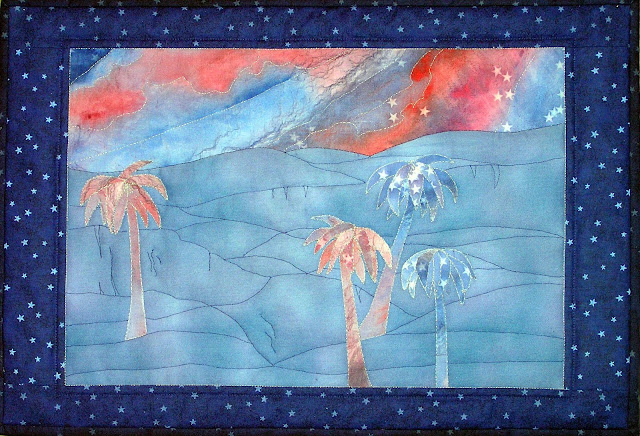Quilt No. 120
Over the last year or so I kept seeing fairy creatures
everywhere. This hadn’t happened to me
since I was five, and my dad and I worked our way through “Fifty Famous Fairy
Tales,” one story at a time. I still
have the book’s alarming illustration of a green-ink line drawing of
Rumpelstiltskin seared into my brain. The
artist certainly captured the rumpel, not to mention the stilt and the
skin! Fairies are once again
popular. They’re in gardens where they
have houses, furniture, flower pots, or just humble doors backed up against
tree trunks. They grace t-shirts and
cupcakes, make their appearance in calendars and continue in their unbroken stint
as popular Halloween costumes.
So I thought -- wouldn’t it be fun to do a quilt with a
fairy on it?
I looked at lots of pictures of fairies in Google
images. They certainly were plentiful
and elegant. Once again the lush
illustration style popular in the early 20th century story books
caught my eye. So many enticing fairy
creatures to choose from!
I’m also rather fond of quilting frogs, so when I found Ida
Rentoul Outhwaite’s 1922 painting with both a frog and a fairy, I knew it was
the one. The fairy was particularly
beautiful, so gentle with her captivating pink dress and gauzy wings. And the frog!
He was the quintessential frog that we all dream of – plump and green
with an essence of royal frogginess that hinted at a princely lineage.
 |
| Ida Rentoul Outhwaite's Original Artwork |
I was in fact, so enamored with Outhwaite’s artwork, that I completely
took leave of my senses, forgetting the rules I have about things that I don’t quilt: hands, faces,
feet. There’s a special subcategory of frog hands and feet that I particularly
like to avoid, having previously driven myself to the brink of insanity while trying
to needle turn the fabric to make slender frog fingers. It was just like childbirth. I completely forgot how wretched it was the
first time around, leaving myself open to repeating the suffering. And in terms of suffering, the frog and the
fairy did not disappoint.
Their genesis in fabric was long and dizzying in its
repetitiveness. I became a card carrying
resident in the land of Do-Over. At one point I was calling the quilt The Six
Faced Fairy, a much needed bit of levity that took me through the six tries it
took to do the fairy’s face. Her arms
took four tries, and her hair, dress, and legs a mere two attempts. Only her wings were nailed on the first pass. What
I learned (re-learned) from this was that my rule about no faces, hands, or
feet, is completely valid. However, I didn’t
think Ms. Outhwaite would have approved of me adding galoshes and mitts to her
fairy.
I like to name a quilt early on in its creation, but this
one remained nameless until after it was completely finished. Nothing came to mind other than the
utilitarian “Frog and Fairy” possibility.
Ugh. I didn’t even know their
names or their story. Observing them,
it’s clear that they are embroiled in a situation. A question is being asked, or a plea is being
put forward, or maybe a controversial point is being painfully explained. Yet, despite having birthed them from the
fabric fragments in a drawer, I could only guess at the topic of their
debate.
I needed to find out more about these two characters who had
eaten up six months of my creative life.
The illustration is from the story book, The Little Green Road to Fairyland.
It’s an Australian book written by Annie Rentoul, and illustrated by her
sister Ida Rentoul Outhwaite. Ida’s
illustrations were so captivating that the stories were crafted around them,
not the reverse which is the usual case.
While very popular in Australia and England, I don’t think any version of
the book was released in North America.
According to the combined international listings in the online
WorldCat catalog, only one library in Canada has a copy, (none in the U.S), and
that library is over 800 km from where I live. Considered a rare book, it seemed unlikely
they’d be willing to mail it out on interlibrary loan. Purchasing a used copy of this almost 100 year
old book was also out of the question at a cost exceeding $US 200. Sadly, no
copies are scanned into Project Gutenberg.
I was going to have to get creative if I wanted to dig up the name of that frog!
Wouldn’t libraries in Australia have a copy of the book? I looked in the online catalogs of their
national and state libraries, and they did indeed have the book in their
various collections. On the website of
the State Library of South Australia, located in Adelaide, I noticed that there
was a form I could fill in to ask a reference question. Bonus - international requests were
accepted! And what could be a more
important international question than the names of this frog and fairy? I filled it in and sent them a photo of
the quilt so they would know which illustration was of importance to me. After two weeks and plenty of breath-holding
on my part, my answer arrived. The frog
is named Kexy. Disappointingly, the
fairy has no name, and is simply referred to as “Fairy” but the location in the
book places them at Old Tranquility Farm.
I had my answer and my quilt title: The Pond at Old Tranquility Farm; Kexy and
the Fairy.
I still don’t know what their debate is about, but since they
refused to reveal it in the six months we spent locked in mortal quilting
combat, perhaps it’s too personal and I shouldn’t pry.


















